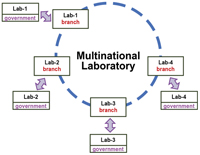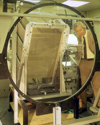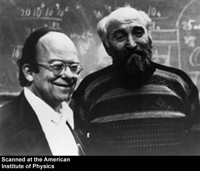Your chance to influence the Project Design Guidance
Jonathan Bagger invites the ILC community to comment on white paper

A conceptual supporting model of a multinational-laboratory |
At the end of 2012, the Global Design Effort (GDE) will release its Technical Design Report. At the same time, the Research Directorate (RD) and the ILC community will produce detailed baseline designs for two detectors.
What then?
This is the question being addressed by the International Linear Collider Steering Committee (ILCSC), the body charged by the International Committee for Future Accelerators (ICFA) with overseeing the design of the ILC and its detectors.
Read more...
-- Jonathan Bagger, Chair, the International Linear Collider Steering Committee
|
 |
|
|
 |
| Upcoming meetings, conferences, workshops
eCloud 2010
Cornell University, NY, USA
8-12 October 2010
 International Workshop on Linear Colliders 2010 (IWLC2010)
ECFA-CLIC-ILC joint meeting International Workshop on Linear Colliders 2010 (IWLC2010)
ECFA-CLIC-ILC joint meeting
CERN and CIGC, Switzerland
18-22 October 2010
2010 IEEE Nuclear Science Symposium and Medical Imaging Conference
Knoxville, Tennessee, USA
30 October - 6 November 2010
SiD Workshop
University of Oregon, Eugene, Oregon, USA
15-17 November 2010
X-Band Structures, Beam Dynamics and Sources Workshop (XB-10)
Cockcroft Institute, Daresbury, UK
30 November - 3 December 2010
Upcoming schools
Fifth International Accelerator School for Linear Colliders
Villars-sur-Ollon, Switzerland
25 October - 5 November 2010
|
|
|
GDE Meetings calendar
View complete ILC calendar
|
|
|
 |
Georges Charpak: a revolution in particle detection

Georges Charpak invents the multi-wire proportional chamber in 1968. Image CERN |
It's hard to imagine a particle physics experiment that wouldn't use one of his concepts. Georges Charpak, Nobel Prize-winning physicist, passed away last week. Particle physicists owe him a lot, and so does the general public, since his inventions yield applications in many other fields that use ionising radiation such as biology, radiology and nuclear medicine.
Georges Charpak, CNRS then CERN experimental physicist, revolutionised particle detection in 1968 and was awarded the Nobel Prize in physics in 1992 "for his invention and development of particle detectors, in particular the multiwire proportional chamber."
Read more...
-- Perrine Royole-Degieux
|
 |
|
|
 |
From Nobel Foundation
5 October 2010
The Nobel Prize in Physics 2010: Andre Geim, Konstantin Novoselov
The Nobel Prize in Physics 2010 was awarded jointly to Andre Geim and Konstantin Novoselov "for groundbreaking experiments regarding the two-dimensional material graphene"
Read more... |
|
From GSI
4 October 2010
International agreement on the FAIR international accelerator facility
Nine countries are involved in one of the world’s largest research projects in Darmstadt
Read more... |
|
From New York Times
3 October 2010
Georges Charpak, Physics Nobel Winner, Dies at 86
Georges Charpak, who won the 1992 Nobel Prize in Physics for inventing a device to sift through the billions of hurtling subatomic particles liberated by collisions in atom smashers, opening the way for discoveries on the nature of matter, died on Wednesday in Paris
Read more... |
|
From INFN
1 October 2010
SuperB project moves forward, preparing for construction
SuperB has now completed and published on arXiv.org a series of progress reports detailing the impressive progress made since the CDR, in consolidating the physics case (arXiv:1008.1541 [hep-ex]) and the design, cost and schedule of the SuperB detector and accelerator.
Read more... |
|
From The Guardian
30 September 2010
Scientists threatening to leave Britain: case studies
Five of the UK's leading experts tell how cuts to research funding are forcing them to look abroad
Read more... |
|
From The Pioneer
30 September 2010
Upcoming Barish lecture appeals to scientists, non-scientists alike
Dr. Barry Barish, a leading member in the field of physics, is coming to Whitman College on Thursday, Sept. 30 to give a lecture on general relativity.
Read more... |
|
|
 |
Novosibirsk

Pief Panofsky with Gersh Budker at the Institution of Nuclear Physics in Novosibirsk. |
I had the interesting experience recently of spending four days at a meeting in Novosibirsk, Russia. I was an invited speaker at the 13th CERN-ISTC SAC seminar entitled "New Perspectives of High Energy Physics." The seminar was held at the Budker Institute for Nuclear Physics (BINP), a famous laboratory credited with many of the innovations in modern particle accelerators. I will write separately about the ISTC (International Science and Technology Center) seminar. This week I focus on our venue, and its history and impressive contributions to particle accelerators. Those of us who have worked on or done research using particle accelerators are well aware of the various schemes invented and developed in Novosibirsk.
Read more...
-- Barry Barish
Director's Corner Archive |
 |
|
|
 |
arXiv preprints
1010.0052
Lepton flavor violating signals of the LHT model via e+e- and γγcollisions at the ILC
1009.5961
P/CP Conserving CP/P Violation Solves Strong CP Problem
|
|

